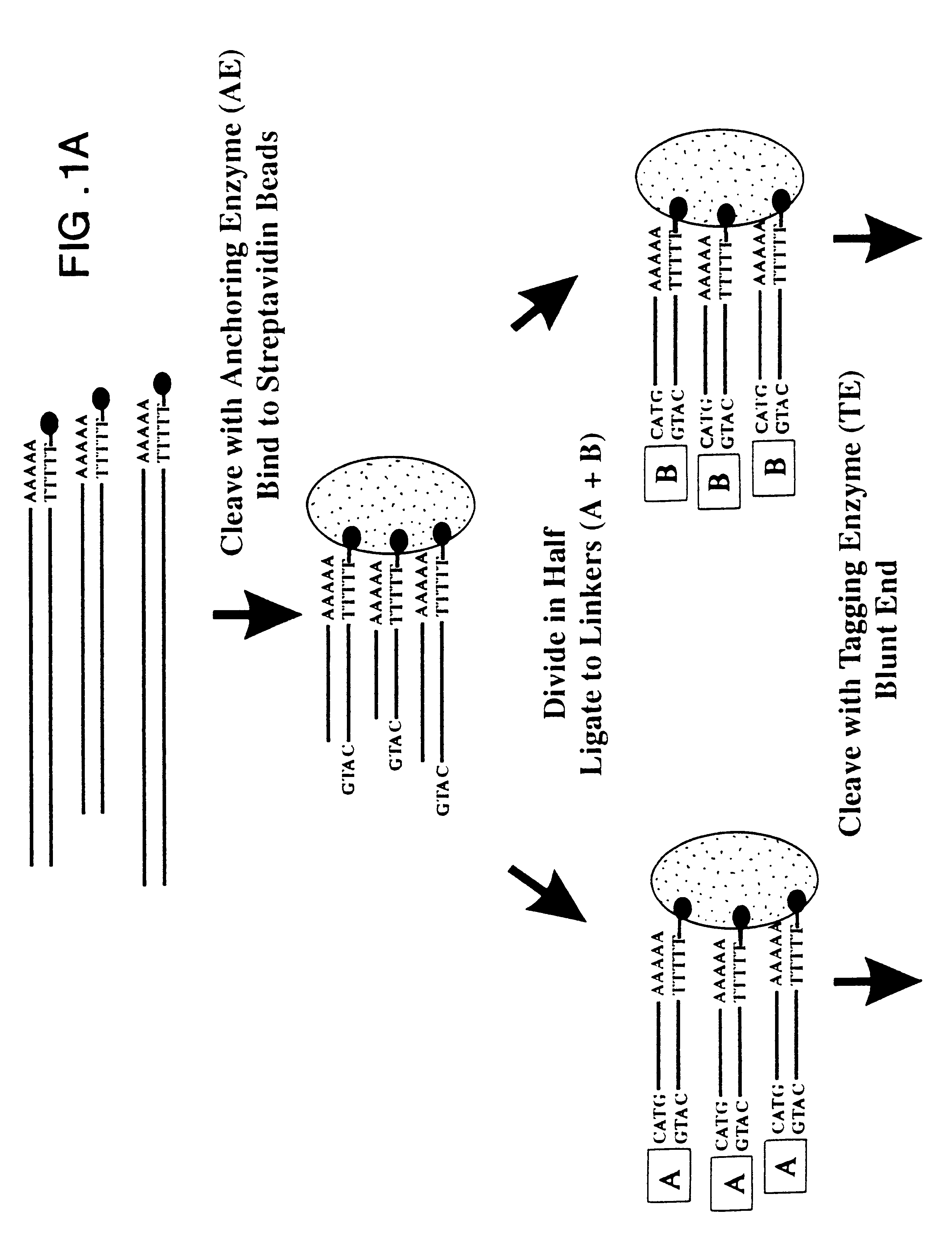Method for serial analysis of gene expression
a gene expression and serial analysis technology, applied in the field of serial analysis of gene expression, can solve the problems of unsatisfactory cdna sequencing of transcribed regions of the genome, mrnas are abundant while others are rare, and represent one level of genetic complexity
- Summary
- Abstract
- Description
- Claims
- Application Information
AI Technical Summary
Problems solved by technology
Method used
Image
Examples
example i
As outlined above, mRNA from human pancreas was used to generate ditags. Briefly, five ug mRNA from total pancreas (Clontech) was converted to double stranded cDNA using a BRL cDNA synthesis kit following the manufacturer's protocol, using the primer biotin-5'T.sub.18 -3'. The cDNA was then cleaved with NlaIII and the 3' restriction fragments isolated by binding to magnetic streptavidin beads (Dynal). The bound DNA was divided into two pools, and one of the following linkers ligated to each pool:
5'-TTTTACCAGCTTATTCAATTCGGTCCTCTCGCACAGGGACATG-3'
3'-ATGGTCGAATAAGTTAAGCCAGGAGAGCGTGTCCCT-5' (SEQ ID NO:1 and 2)
5'-TTTTTGTAGACATTCTAGTATCTCGTCAAGTCGGAAGGGACATG-3'
3'- AACATCTGTAAGATCATAGAGCAGTTCAGCCTTCCCT-5' (SEQ ID NO:3 and 4), where A is a dideoxy nucleotide (e.g., dideoxy A).
After extensive washing to remove unlighted linkers, the linkers and adjacent tags were released by cleavage with BsmFI. The resulting overhangs were filled in with T4 polymerase and the pools combined and ligated to ea...
example 2
The quantitative nature of SAGE was evaluated by construction of an oligo-dT primed pancreatic cDNA library which was screened with cDNA probes for trypsinogen 1 / 2, procarboxpeptidase A1, chymotrypsinogen and elastase I-IIB / protease E. Pancreatic mRNA from the same preparation as used for SAGE in Example 1 was used to construct a cDNA library in the ZAP Express vector using the ZAP Express cDNA Synthesis kit following the manufacturer's protocol (Stratagene). Analysis of 15 randomly selected clones indicated that 100% contained cDNA inserts. Plates containing 250 to 500 plaques were hybridized as previously described (Ruppert, et al., Mol. Cell. Biol. 8:3104, 1988). cDNA probes for trypsinogen 1, trypsinogen 2, procarboxypeptidase A1, chymotrypsinogen, and elastase IIIB were derived by RT-PCR from pancreas RNA. The trypsinogen 1 and 2 probes were 93% identical and hybridized to the same plaques under the conditions used. Likewise, the elastase IIIB probe and protease E probe were ov...
example 3
In addition to providing quantitative information on the abundance of known transcripts, SAGE could be used to identify novel expressed genes. While for the purposes of the SAGE analysis in this example, only the 9 bp sequence unique to each transcript was considered, each SAGE tag defined a 13 bp sequence composed of the anchoring enzyme (4 bp) site plus the 9 bp tag. To illustrate this potential, 13 bp oligonucleotides were used to isolate the transcripts corresponding to four unassigned tags (P1 to P4), that is, tags without corresponding entries from GenBank R87 (Table 1). In each of the four cases, it was possible to isolate multiple cDNA clones for the tag by simply screening the pancreatic cDNA library using 13 bp oligonucleotide as hybridization probe (examples in FIG. 3).
Plates containing 250 to 2,000 plaques were hybridized to oligonucleotide probes using the same conditions previously described for standard probes except that the hybridization temperature was reduced to r...
PUM
| Property | Measurement | Unit |
|---|---|---|
| length | aaaaa | aaaaa |
| Northern blotting | aaaaa | aaaaa |
| size | aaaaa | aaaaa |
Abstract
Description
Claims
Application Information
 Login to View More
Login to View More - R&D
- Intellectual Property
- Life Sciences
- Materials
- Tech Scout
- Unparalleled Data Quality
- Higher Quality Content
- 60% Fewer Hallucinations
Browse by: Latest US Patents, China's latest patents, Technical Efficacy Thesaurus, Application Domain, Technology Topic, Popular Technical Reports.
© 2025 PatSnap. All rights reserved.Legal|Privacy policy|Modern Slavery Act Transparency Statement|Sitemap|About US| Contact US: help@patsnap.com



